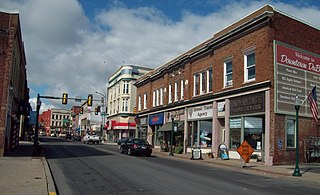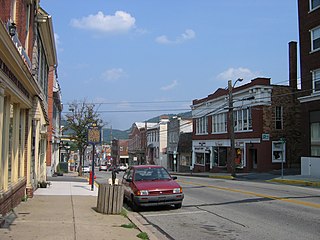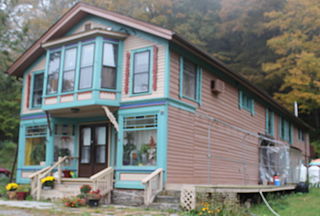
St. Katherine's Historic District is located on the east side Davenport, Iowa, United States and is listed on the National Register of Historic Places. It is the location of two mansions built by two lumber barons until it became the campus of an Episcopal girls' school named St. Katharine's Hall and later as St. Katharine's School. The name was altered to St. Katharine-St. Mark's School when it became coeducational. It is currently the location of a senior living facility called St. Katherine's Living Center.

Dubois Historic District is a national historic district located at Dubois, Clearfield County, Pennsylvania. The district includes 54 contributing buildings in the central business district of Dubois. The district consists of mostly commercial buildings built after the fire of 1888 and in a variety of popular architectural styles including Gothic Revival architecture, Italianate, and Romanesque Revival. Notable buildings include the Hatten & Munch Building (1897), Moore & Schwern Building, Methodist Episcopal Church (1889), First Baptist Church (1891), Shaw Building (1895), and DuBois Public Library (1923). Located in the district and separately listed was the Commercial Hotel.

The Bedford Historic District is a national historic district located in Bedford, Bedford County, Pennsylvania. The district includes two hundred and ten contributing buildings in the central business district and surrounding residential areas of Bedford.

The Marklesburg Historic District is a national historic district that is located in Marklesburg in Huntingdon County, Pennsylvania.

Revloc Historic District is a national historic district located at Cambria Township in Cambria County, Pennsylvania. The district includes 203 contributing buildings, one contributing site, and one contributing structure. The district consists of residential areas and utilitarian industrial buildings associated with the Monroe Coal Mining Company and developed between 1917 and 1944. The mine was serviced by the Cambria and Indiana Railroad. Notable buildings include a variety of brick and frame miners' housing, stone company store (1918), payroll office, company boiler house, supply house, machine and blacksmith shop, Revloc Presbyterian Church (1923), Most Holy Redeemer Catholic Church (1924), and Revloc School.

Cambria City Historic District is a national historic district located at Johnstown in Cambria County, Pennsylvania. The district includes 198 contributing buildings and 1 contributing structure in a predominantly working-class residential area of Johnstown. Though predominantly residential, it also includes a small business district and industrial buildings such as a former brewery, bottling plant, and slaughter house, along with a notable collection of churches, schools, and fire station. The district includes some buildings dated before the Johnstown Flood, but the majority date from 1890 to 1920. Notable buildings include the collection of two-story, balloon frame, detached and semi-detached dwellings, Fifth Avenue Hotel (1889), Pollack Building (1905), former Cambria Fire Hose and Ladder Company (1890), former Germana Brewery (1907), August and Louisa Mayer Building (1907), Tulip Bottling Company (1913-1949), St. Casimer's Polish Church (1907), Immaculate Conception Church (1908), St. Stephen's Slovak Church (1914), St. Columba Church (1914), St. Mary's Greek Catholic Church (1922), Venue Of Merging Arts, Hungarian Reformed Church (1902), and First Catholic Slovak Band Hall (1913-1949). The contributing structure is the Minersville Bridge (1914).

The Moxham Historic District is a national historic district that is located in Johnstown in Cambria County, Pennsylvania.

The Old Conemaugh Borough Historic District is a national historic district that is located in Johnstown in Cambria County, Pennsylvania.

Westmont Historic District is a national historic district located at Westmont in Cambria County, Pennsylvania. The district includes 430 contributing buildings and 2 contributing sites in a predominantly residential area of eastern Westmont. The dwellings are in a variety of late-19th and early-20th-century architectural styles including Colonial Revival, Queen Anne, and Arts and Crafts styles. Notable buildings include the Charles Price House (1891), David Cohoe House, Love House (1912), John C. Ogden House, John Schonhardt House, Frank Buchanan House (1894), Harry S. Endsley House (1895), J. Leonard Replogle House, Elmer E. Stimmel House, F. J. Varner House, Our Mother of Sorrows Catholic Church (1924), and Westmont Presbyterian Church (1926). The contributing sites are The Mound and Indian Mound or Reservoir Park.

Towanda Historic District is a national historic district located at Towanda, Bradford County, Pennsylvania. The district includes 440 contributing buildings and 1 contributing site in the central business district and surrounding residential areas of Towanda. The buildings date between about 1830 and 1900, and include notable examples of vernacular and high style Greek Revival, Queen Anne, and Classical Revival style architecture. Notable buildings include the William Means House (1816), Towanda Academy (1835), Dr. Samuel Huston House, Ulysses Mercur House (1851), David Cash House (1845), Presbyterian Church (1855), SS Peter and Paul Church (1869-1879), Hale Opera House (1886), Episcopal Church (1889), Citizens National Bank (1888), Kingsbury / Chamberlain Building (1887), Dan Turner House (1897), Public Library (1897), and the Riverside Cemetery. Located in the district and separately listed is the Bradford County Courthouse.

The Lansdowne Park Historic District is a national historic district that is located in Lansdowne, Delaware County, Pennsylvania, USA.

Dawson Historic District is a national historic district located at Dawson, Fayette County, Pennsylvania. The district includes 107 contributing buildings in the central business district and surrounding residential areas of Dawson. The oldest building is the log Cochran House. Most of the contributing buildings were built between 1870 and 1940, and are representative of a number of popular architectural styles including Bungalow / American Craftsman, Classical Revival, and Queen Anne. Other notable buildings include the Dawson Baptist Church, James Cochran House, W. H. Cochran House (1880s), Rist House (1880s), First National Bank (1897), and Masonic Hall. The Cochran Memorial United Methodist Church is located in the district and listed separately.

Chambersburg Historic District is a national historic district centered on the Memorial Fountain and Square of Chambersburg in Franklin County, Pennsylvania. The district includes 159 contributing buildings in the central business district and immediately surrounding residential area of Chambersburg. The district has a number of notable examples of Georgian and Italianate style architecture. Notable buildings include the St. Paul United Methodist Church (1896), Professional Arts Building, Cumberland Valley National Bank, Cumberland Valley Railroad Station, First United Brethren Church (1899), firehouse, Presbyterian Church of the Falling Spring (1803), and the Suesserott House. Located in the district and separately listed are the Franklin County Jail, Franklin County Courthouse, John Brown House, Masonic Temple, Townhouse Row, and the Zion Reformed Church.

River Street Historic District is a national historic district located at Wilkes-Barre, Pennsylvania. The district includes 215 contributing buildings built between 1860 and 1930, which include notable examples of the Beaux Arts and Gothic Revival styles. Many of the contributing dwellings incorporate Wyoming Bluestone into the foundations and dressings. It was added to the National Register of Historic Places in 1985.

Tamaqua Historic District is a national historic district located at Schuylkill Township and Tamaqua, Schuylkill County, Pennsylvania. The district includes 944 contributing buildings, 3 contributing sites, 8 contributing structures, and 3 contributing objects in the central business district and surrounding residential areas of Tamaqua. The residential buildings principally date to the early 20th century. They are mostly two-story, of brick and frame construction, and in a variety of popular architectural styles including Queen Anne, Late Victorian, Italianate, and Colonial Revival. Notable non-residential buildings include the Little Schuylkill Hotel (1827), White Swan, Washington House, Shepp Building, Elks Lodge, Peoples Trust Company Building, Tamaqua National Bank (1908), First National Bank of Tamaqua, U.S. Post Office (1932), Majestic Theater and Hotel, Hegarty Blacksmith Shop (1848), Conrad Biscoff Planing Mill and Furniture Factory (1865), Tamaqua Manufacturing Company (1910), Calvary Episcopal Church (1851), First Methodist Church (1852), St. Jerome's Roman Catholic Church (1856), American Hose Company (1881), East End Fire Co. (1923), and the former Tamaqua Armory. The contributing sites are St. Jerome's Cemetery, Odd Fellows Cemetery (1865), and the foundation of the Fitzpatrick Shirt Factory (1888). Contributing structures include three runs of iron steps and five bridges. Located in the district and separately listed are the Anthracite Bank Building, George Ormrod House, and Tamaqua Railroad Station.

Damascus Historic District, is a national historic district located within Damascus Village in Damascus Township, Wayne County, Pennsylvania. The district includes 36 contributing buildings, 2 contributing sites, and 2 contributing structures in the community of Damascus. The buildings are in a variety of popular architectural styles including Greek Revival, Queen Anne, and Renaissance Revival. Notable buildings include the Baptist Church, Damascus Academy, Vail and Appley Store, Methodist Church (1857), Philip O'Reilly House, and Luther Appley House. The sites are the Hillside Cemetery and Overlook Cemetery.

The Milanville Historic District, is a national historic district that is located in Damascus Township, Wayne County, Pennsylvania.

Equinunk Historic District is a national historic district located at Buckingham Township and Manchester Township, Wayne County, Pennsylvania. The district includes 55 contributing buildings and 1 contributing site in the community of Equinunk. The buildings are vernacular interpretations of a variety of popular 19th- and early-20th-century architectural styles including Greek Revival, Italianate, Gothic Revival, Second Empire, and Queen Anne. Notable buildings include Nelson's Store, Calder House, Nelson House, Barnes House (1901), Bullock's Store, Taft Hotel, Bleck's Hotel (1905), and Equinunk Methodist Church (1895). The contributing site is the Equinunk Cemetery.

West Washington Historic District is a national historic district located at South Bend, St. Joseph County, Indiana. It encompasses 330 contributing buildings in an upper class residential section of South Bend. It developed between about 1854 and 1910, and includes notable examples of Italianate, Greek Revival, and Romanesque Revival style architecture. Located in the district are the separately listed Morey-Lampert House, Oliver Mansion designed by Lamb and Rich, Second St. Joseph County Courthouse, South Bend Remedy Company Building, and Tippecanoe Place. Other notable buildings include the Bartlett House (1850), Birdsell House (1897), DeRhodes House designed by Frank Lloyd Wright, Holley House, Kaiser-Schmidt House, Listenberger-Nemeth House, Meahger-Daughterty House (1884), O'Brien House, Oren House, The People's Church (1889), St. Hedwig's Church, St. Patrick's Church (1886), St. Paul's Memorial United Methodist Church (1901), West House, and a row of worker's houses.

Jefferson Historic District is a national historic district located at Lafayette, Tippecanoe County, Indiana. The district encompasses 161 contributing buildings, 2 contributing sites, and 22 contributing structures in a predominantly residential section of Lafayette. It developed between about 1853 and 1951 and includes representative examples of Italianate, Greek Revival, and Bungalow / American Craftsman style architecture. Notable contributing resources include the Deutsche Evangelische Kirche (1905), Isador Metzger House, Hubert Gilmartin House, B.F. Biggs Pump Factory Building, Deutsche Methodist Kirche (1885), Herman & Mary Fletemeyer House, Mohr House, Warrenberg-Reule Double House, Alfred Gaddis House, Wabash Valley House (1862), Haywood Tag Company Building (1928), and Jefferson High School (1927).
























